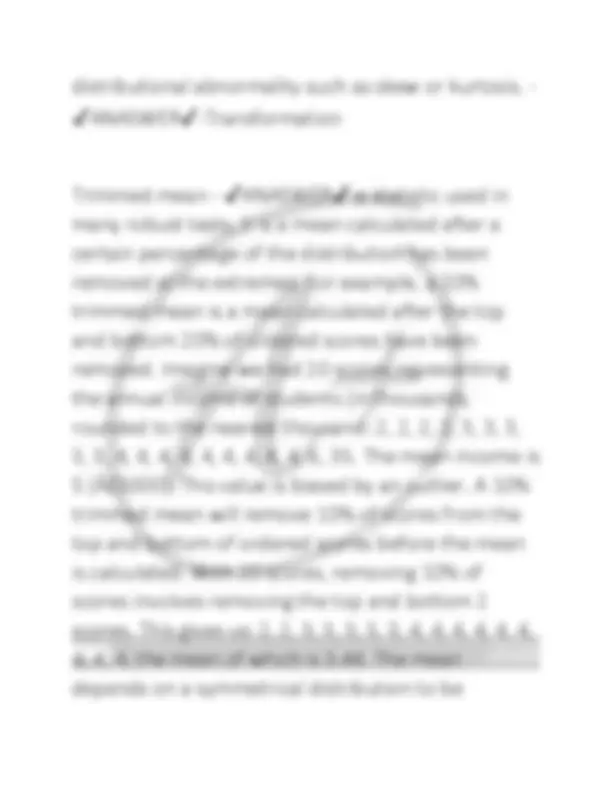






























































































Study with the several resources on Docsity

Earn points by helping other students or get them with a premium plan


Prepare for your exams
Study with the several resources on Docsity

Earn points to download
Earn points by helping other students or get them with a premium plan
Community
Ask the community for help and clear up your study doubts
Discover the best universities in your country according to Docsity users
Free resources
Download our free guides on studying techniques, anxiety management strategies, and thesis advice from Docsity tutors
Discovering SPSS Statistics Questions & answers 2025 ( A+ GRADED 100% VERIFIED)
Typology: Exams
1 / 242

This page cannot be seen from the preview
Don't miss anything!





























































































Discovering SPSS Statistics Questions & answers 2025 ( A+ GRADED 100% VERIFIED) Binary variable - ✔ANASWER✔-a categorical variable that has only two mutually exclusive categories (e.g., being dead or alive). Between-groups design - ✔ANASWER✔-another name for independent design.
another name for independent design. - ✔ANASWER✔-Between-groups design Between-subjects design - ✔ANASWER✔-another name for independent design. another name for independent design. - ✔ANASWER✔-Between-subjects design Bimodal - ✔ANASWER✔-a description of a distribution of observations that has two modes. a description of a distribution of observations that has two modes. - ✔ANASWER✔-Bimodal a categorical variable that has only two mutually exclusive categories (e.g., being dead or alive). - ✔ANASWER✔-Binary variable
Sussex are not also enrolled at Harvard or UV Amsterdam, therefore, students fall into distinct categories. The university you attend is a good example of a categorical variable: students who attend the University of Sussex are not also enrolled at Harvard or UV Amsterdam, therefore, students fall into distinct categories. - ✔ANASWER✔-Categorical variable Central tendency - ✔ANASWER✔-a generic term describing the centre of a frequency distribution of observations as measured by the mean, mode and median. a generic term describing the centre of a frequency distribution of observations as measured by the mean, mode and median. - ✔ANASWER✔-Central tendency
Concurrent validity - ✔ANASWER✔-a form of criterion validity where there is evidence that scores from an instrument correspond to concurrently recorded external measures conceptually related to the measured construct. a form of criterion validity where there is evidence that scores from an instrument correspond to concurrently recorded external measures conceptually related to the measured construct. - ✔ANASWER✔-Concurrent validity Confounding variable - ✔ANASWER✔-a variable (that we may or may not have measured) other than the predictor variables in which we're interested that potentially affects an outcome variable. a variable (that we may or may not have measured) other than the predictor variables in which we're
there is in principle no limit on how finely it could be measured.) - ✔ANASWER✔-Continuous variable Correlational research - ✔ANASWER✔-a form of research in which you observe what naturally goes on in the world without directly interfering with it. This term implies that data will be analysed so as to look at relationships between naturally occurring variables rather than making statements about cause and effect. Compare with cross-sectional research, longitudinal research and experimental research. a form of research in which you observe what naturally goes on in the world without directly interfering with it. This term implies that data will be analysed so as to look at relationships between naturally occurring variables rather than making statements about cause and effect. Compare with cross-sectional research, longitudinal research and
experimental research. - ✔ANASWER✔-Correlational research Counterbalancing - ✔ANASWER✔-a process of systematically varying the order in which experimental conditions are conducted. In the simplest case of there being two conditions (A and B), counterbalancing simply implies that half of the participants complete condition A followed by condition B, whereas the remainder do condition B followed by condition A. The aim is to remove systematic bias caused by practice effects or boredom effects. a process of systematically varying the order in which experimental conditions are conducted. In the simplest case of there being two conditions (A and B), counterbalancing simply implies that half of the participants complete condition A followed by condition B, whereas the remainder do condition B followed by condition A. The aim is to remove
come from people at different age points, with different people representing each age point. See also correlational research, longitudinal research. a form of research in which you observe what naturally goes on in the world without directly interfering with it, by measuring several variables at a single time point. In psychology, this term usually implies that data come from people at different age points, with different people representing each age point. See also correlational research, longitudinal research. - ✔ANASWER✔-Cross-sectional research Dependent variable - ✔ANASWER✔-another name for outcome variable. This name is usually associated with experimental methodology (which is the only time it really makes sense) and is used because it is the variable that is not manipulated by the experimenter and so its value depends on the variables that have been manipulated. To be honest
I just use the term outcome variable all the time - it makes more sense (to me) and is less confusing. another name for outcome variable. This name is usually associated with experimental methodology (which is the only time it really makes sense) and is used because it is the variable that is not manipulated by the experimenter and so its value depends on the variables that have been manipulated. To be honest I just use the term outcome variable all the time - it makes more sense (to me) and is less confusing. - ✔ANASWER✔- Dependent variable Deviance - ✔ANASWER✔-the difference between the observed value of a variable and the value of that variable predicted by a statistical model.
Experimental research - ✔ANASWER✔-a form of research in which one or more variables are systematically manipulated to see their effect (alone or in combination) on an outcome variable. This term implies that data will be able to be used to make statements about cause and effect. Compare with cross-sectional research and correlational research. a form of research in which one or more variables are systematically manipulated to see their effect (alone or in combination) on an outcome variable. This term implies that data will be able to be used to make statements about cause and effect. Compare with cross-sectional research and correlational research. - ✔ANASWER✔-Experimental research Falsification - ✔ANASWER✔-the act of disproving a hypothesis or theory.
the act of disproving a hypothesis or theory. - ✔ANASWER✔-Falsification Frequency distribution - ✔ANASWER✔-a graph plotting values of observations on the horizontal axis, and the frequency with which each value occurs in the data set on the vertical axis (a.k.a. histogram). a graph plotting values of observations on the horizontal axis, and the frequency with which each value occurs in the data set on the vertical axis (a.k.a. histogram). - ✔ANASWER✔-Frequency distribution Histogram - ✔ANASWER✔-a frequency distribution. a frequency distribution. - ✔ANASWER✔-Histogram
in different treatment conditions) and so the resulting data are independent (a.k.a. between- groups or between-subjects design). - ✔ANASWER✔-Independent design Independent variable - ✔ANASWER✔-another name for a predictor variable. This name is usually associated with experimental methodology (which is the only time it makes sense) and is used because it is the variable that is manipulated by the experimenter and so its value does not depend on any other variables (just on the experimenter). I just use the term predictor variable all the time because the meaning of the term is not constrained to a particular methodology. another name for a predictor variable. This name is usually associated with experimental methodology (which is the only time it makes sense) and is used because it is the variable that is manipulated by the experimenter and so its value does not depend on
any other variables (just on the experimenter). I just use the term predictor variable all the time because the meaning of the term is not constrained to a particular methodology. - ✔ANASWER✔- Independent variable Interquartile range - ✔ANASWER✔-the limits within which the middle 50% of an ordered set of observations fall. It is the difference between the value of the upper quartile and lower quartile. the limits within which the middle 50% of an ordered set of observations fall. It is the difference between the value of the upper quartile and lower quartile. - ✔ANASWER✔-Interquartile range Interval variable - ✔ANASWER✔-data measured on a scale along the whole of which intervals are equal. For example, people's ratings of this book on Amazon.com can range from 1 to 5; for these data
learned helplessness in scientists through a complex process of self-esteem regulation using excessively harsh or complimentary peer feedback that has seemingly no obvious correlation with the actual quality of the work submitted. In the context of academia a journal is a collection of articles on a broadly related theme, written by scientists, that report new data, new theoretical ideas or reviews/critiques of existing theories and data. Their main function is to induce learned helplessness in scientists through a complex process of self-esteem regulation using excessively harsh or complimentary peer feedback that has seemingly no obvious correlation with the actual quality of the work submitted. - ✔ANASWER✔-Journal Kurtosis - ✔ANASWER✔-this measures the degree to which scores cluster in the tails of a frequency distribution. There are different ways to estimate kurtosis and in SPSS no kurtosis is expressed as 0
(but be careful because outside of SPSS no kurtosis is sometimes a value of 3). A distribution with positive kurtosis (leptokurtic, kurtosis > 0) has too many scores in the tails and is too peaked, whereas a distribution with negative kurtosis (platykurtic, kurtosis < 0) has too few scores in the tails and is quite flat. this measures the degree to which scores cluster in the tails of a frequency distribution. There are different ways to estimate kurtosis and in SPSS no kurtosis is expressed as 0 (but be careful because outside of SPSS no kurtosis is sometimes a value of 3). A distribution with positive kurtosis (leptokurtic, kurtosis > 0) has too many scores in the tails and is too peaked, whereas a distribution with negative kurtosis (platykurtic, kurtosis < 0) has too few scores in the tails and is quite flat. - ✔ANASWER✔-Kurtosis Leptokurtic - ✔ANASWER✔-see Kurtosis.